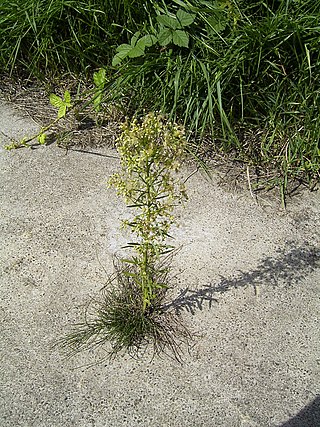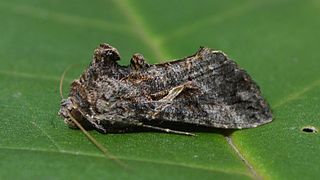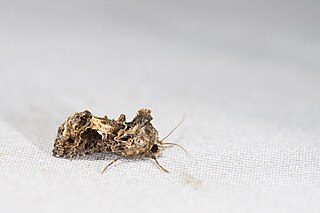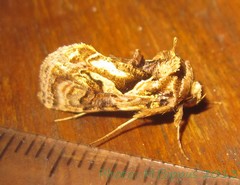
The potato is a starchy root vegetable native to the Americas that is consumed as a staple food in many parts of the world. Potatoes are tubers of the plant Solanum tuberosum, a perennial in the nightshade family Solanaceae.

Eggplant, aubergine, brinjal, or baigan (GY) is a plant species in the nightshade family Solanaceae. Solanum melongena is grown worldwide for its edible fruit.

Erigeron is a large genus of plants in the composite family (Asteraceae). It is placed in the tribe Astereae and is closely related to the Old World asters (Aster) and the true daisies (Bellis). The genus has a cosmopolitan distribution, but the highest diversity occurs in North America.

Solanum mauritianum is a small tree or shrub native to South America, including Northern Argentina, Southern Brazil, Paraguay and Uruguay. Its common names include earleaf nightshade, woolly nightshade, flannel weed, bugweed, tobacco weed, tobacco bush, wild tobacco and kerosene plant.

Erigeron bonariensis is a species in the family Asteraceae, found throughout the tropics and subtropics as a pioneer plant; its precise origin is unknown, but most likely it stems from Central America or South America. It has become naturalized in many other regions, including North America, Europe and Australia. Common names include flax-leaf fleabane, wavy-leaf fleabane, Argentine fleabane, hairy horseweed, asthma weed and hairy fleabane.

The greater grison is a species of mustelid native to Southern Mexico, Central America, and South America.

Erigeron canadensis is an annual plant native throughout most of North America and Central America. It is also widely naturalized in Eurasia and Australia. Common names include horseweed, Canadian horseweed, Canadian fleabane, coltstail, marestail, and butterweed. It was the first weed to have developed glyphosate resistance, reported in 2001 from Delaware.

Erigeron foliosus, known by the common names leafy daisy and leafy fleabane, is a North American species of flowering plants in the family Asteraceae.

Tebenna micalis, also known as the small thistle moth, is a species of moth in the family Choreutidae found worldwide. It was first described by the German Bohemian entomologist, Joseph Johann Mann in 1857.

Ctenoplusia is a genus of moths of the family Noctuidae.

Ctenoplusia adiaphora is a moth of the family Noctuidae, first described by Claude Dufay in 1974. It is found in Taiwan.

Ctenoplusia oxygramma is a moth of the family Noctuidae. It is found in southern Ontario, the eastern parts of the United States to Arizona. It has also been reported from Kansas, Nebraska, Iowa, Wisconsin, Mexico, the Antilles and from California south to Brazil and India Argentina.

Ctenoplusia limbirena, the Scar Bank gem, or silver U-tail, is a moth of the family Noctuidae. It is found in south-western Europe, Africa, the Canary Islands, Arabia, the southern Himalayas, India, Sri Lanka, Indochina to south-eastern China, Taiwan, Sulawesi, Bali and Timor. In New Zealand, it has been established since 2011.

Ctenoplusia albostriata, the eastern streaked plusia, is a moth of the family Noctuidae. It is found in India, Sri Lanka, eastern Asia and the Pacific, including Borneo, Hong Kong, Vietnam, Japan, most of Australia and New Zealand.
Ctenoplusia chillagoes is a moth of the family Noctuidae. It is found in Queensland.

Ctenoplusia furcifera is a moth of the family Noctuidae. It is found in south-east Asia and the Pacific, including India, Taiwan, Australia and New Guinea.

Leucinodes laisalis is a species of moth in the family Crambidae.

Ctenoplusia dorfmeisteri is a moth of the family Noctuidae. It is found in western, central and southern Africa, where it's known from Congo, Nigeria, Gabon, Ghana, South Africa, Mauritius, Réunion and from Yemen.
Samuel Bonsall Parish (1838–1928) was a California botanist and curator of the herbarium at Stanford University. A number of plants were named in his honor, including Allium parishii, Atriplex parishii, Boechera parishii, Chaenactis parishii, Cheilanthes parishii, Delphinium parishii ssp. pallidum, Delphinium parishii ssp. parishii, Ericameria parishii, Erigeron parishii, Eriogonum parishii, Eschscholzia parishii, Euphorbia parishii, Galium parishii, Grusonia parishii, Heuchera parishii, Lycium parishii, Malacothamnus parishii, Mimulus parishii, Orobanche parishii ssp. brachyloba, Orobanche parishii ssp. parishii, Perideridia parishii, Phacelia parishii, Plagiobothrys parishii, Puccinellia parishii, Silene parishii, Solanum parishii, Stipa parishii, Symphoricarpos parishii, Tauschia parishii, Trichostema parishii, Viguiera parishii, and others.
Ctenoplusia fracta is a moth of the family Noctuidae first described by Francis Walker in 1858.


















